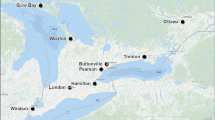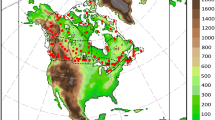Abstract
Hazardous weather related to the occurrence of severe thunderstorms including tornadoes, high-winds, and hail cause significant damage globally to life and property every year. Yet the impact on these storms from a warming climate remains a difficult task due to their transient nature. In this study we investigate the change in large-scale environments in which severe thunderstorms form during twenty-first century warming (RCP2.6 and RCP8.5) in a group of RegCM CORDEX-CORE simulations. Severe potential is measured in terms of Convective Available Potential Energy (CAPE) and vertical wind-shear during the severe seasons in three regions which are known to currently be prone to severe hazards: North America, subtropical South America, and eastern India and Bangladesh. In every region, environments supportive for severe thunderstorms are projected to increase during the warm season months in both the RCP2.6 and RCP8.5 scenarios during the twenty-first century. The number of days supportive for severe thunderstorms increases by several days per season over the vast majority of each region by the end of the century. Analyzing the CAPE and shear trends during the twenty-first century, we find seasonally and regionally specific changes driving the increased severe potential. Twenty-first century surface warming is clearly driving a robust increase in CAPE in all regions, however poleward displacement of vertical shear in the future leads to the displacement of severe environments over North America and South America. The results found here relate that severe impacts in the future cannot be generalized globally, and that regionally specific changes in vertical shear may drive future movement of regions prone to severe weather.















Similar content being viewed by others
References
Allen JT (2018) Climate change and severe thunderstorms. Oxf Res Encycl Clim Sci. https://doi.org/10.1093/acrefore/9780190228620.013.62
Allen J, Karoly D, Mills G (2011) A severe thunderstorm climatology for Australia and associated thunderstorm environments. Aust Meteorol Oceanogr J 61:143–158. https://doi.org/10.22499/2.6103.001
Allen JT, Karoly DJ, Walsh KJ (2014a) Future Australian severe thunderstorm environments. Part I: a novel evaluation and climatology of convective parameters from two climate models for the late twentieth century. J Clim 27:3827–3847. https://doi.org/10.1175/JCLI-D-13-00425.1
Allen JT, Karoly DJ, Walsh KJ (2014b) Future Australian severe thunderstorm environments. Part II: the influence of a strongly warming climate on convective environments. J Clim 27:3848–3868. https://doi.org/10.1175/jcli-d-13-00426.1
Ashfaq M, Cavazos T, Reboita MS et al (2020) Robust late twenty-first century shift in the regional monsoons in RegCM-CORDEX simulations. Clim Dyn. https://doi.org/10.1007/s00382-020-05306-2
Bikos D, Finch J, Case JL (2016) The environment associated with significant tornadoes in Bangladesh. Atmos Res 167:183–195. https://doi.org/10.1016/j.atmosres.2015.08.002
Blamey RC, Middleton C, Lennard C, Reason CJC (2017) A climatology of potential severe convective environments across South Africa. Clim Dyn 49:2161–2178
Brooks HE (2009) Proximity soundings for severe convection for Europe and the United States from reanalysis data. Atmos Res 93:546–553. https://doi.org/10.1016/j.atmosres.2008.10.005
Brooks H (2013) Severe thunderstorms and climate change. Atmos Res 123:129–138. https://doi.org/10.1016/j.atmosres.2012.04.002
Brooks H, Doswell CA (2001) Some aspects of the international climatology of tornadoes by damage classification. Atmos Res 56:191–201. https://doi.org/10.1016/s0169-8095(00)00098-3
Brooks HE, Lee JW, Craven JP (2003a) The spatial distribution of severe thunderstorm and tornado environments from global reanalysis data. Atmos Res 67–68:73–94. https://doi.org/10.1016/s0169-8095(03)00045-0
Brooks HE, Doswell CA, Kay MP (2003b) Climatological estimates of local daily tornado probability for the United States. Weather Forecast 18:626–640. https://doi.org/10.1175/1520-0434(2003)018<0626:ceoldt>2.0.co;2
Cecil DJ, Blankenship CB (2012) Toward a global climatology of severe hailstorms as estimated by satellite passive microwave imagers. J Clim 25:687–703. https://doi.org/10.1175/jcli-d-11-00130.1
Childs SJ, Schumacher RS, Allen JT (2018) Cold-season tornadoes: climatological and meteorological insights. Weather Forecast 33:671–691. https://doi.org/10.1175/WAF-D-17-0120.1
Coumou D, Capua GD, Vavrus S, Wang L, Wang S (2018) The influence of Arctic amplification on mid-latitude summer circulation. Nat Commun. https://doi.org/10.1038/s41467-018-05256-8
Craven JP, Brooks HE (2004) Baseline climatology of sounding derived parameters associated with deep moist convection. Nat Weather Dig 28:13–24
Dee DP et al (2011) The ERA-Interim reanalysis: configuration and performance of the data assimilation system. Q J R Meteorol Soc 137:553–597
Dias MAFS (2011) An increase in the number of tornado reports in Brazil. Weather Clim Soc 3:209–217. https://doi.org/10.1175/2011wcas1095.1
Diffenbaugh NS, Scherer M, Trapp RJ (2013) Robust increases in severe thunderstorm environments in response to greenhouse forcing. Proc Natl Acad Sci 110:16361–16366. https://doi.org/10.1073/pnas.1307758110
Doswell CA, Brooks HE, Kay MP (2005) Climatological estimates of daily local nontornadic severe thunderstorm probability for the United States. Weather Forecast 20:577–595. https://doi.org/10.1175/waf866.1
Doswell CA, Brooks HE, Dotzek N (2009) On the implementation of the enhanced Fujita scale in the USA. Atmos Res 93:554–563. https://doi.org/10.1016/j.atmosres.2008.11.003
Fujita TT (1973) Tornadoes around the World. Weatherwise 26:56–83. https://doi.org/10.1080/00431672.1973.9931633
Gensini VA, Brooks HE (2018) Spatial trends in United States tornado frequency. NPJ Clim Atmos Sci 1:38. https://doi.org/10.1038/s41612-018-0048-2
Gensini VA, Ramseyer C, Mote TL (2014) Future convective environments using NARCCAP. Int J Climatol 34:1699–1705. https://doi.org/10.1002/joc.3769
Giorgi F, Diffenbaugh NS, Gao XJ et al (2008) Exploring uncertainties in regional climate change: the regional climate change hyper-matrix framework. EOS Trans 89:445–446
Giorgi F, Coppola E, Solmon F et al (2012) RegCM4: model description and preliminary tests over multiple CORDEX domains. Clim Res 52:7–29. https://doi.org/10.3354/cr01018
Holton JR (2004) Cumulus convection. An introduction to dynamic meteorology, 4th edn. Elsevier Academic Press, London, p 295
Intergovernmental Panel on Climate Change (2001) Climate Change 2001: the scientific basis: contribution of working group I to the third assessment report of the intergovernmental panel on climate change. In: Houghton JT, Ding Y, Griggs DJ, Noguer M, van der Linden PJ, Dai X, Maskell K, Johnson CA (eds) Cambridge University Press, New York.
Intergovernmental Panel on Climate Change (2014) Climate Change 2014: Synthesis Report. In: Core Writing Team, Pachauri RK, Meyer LA (eds) Contribution of working groups I, II and III to the fifth assessment report of the intergovernmental panel on climate change. IPCC, Geneva, Switzerland
Jungclaus JH, Fischer N, Haak H et al (2013) Characteristics of the ocean simulations in the Max Planck Institute Ocean Model (MPIOM) the ocean component of the MPI-Earth system model. J Adv Model Earth Syst 5:422–446. https://doi.org/10.1002/jame.20023
Klemp JB (1987) Dynamics of tornadic thunderstorms. Annu Rev Fluid Mech 19:369–402. https://doi.org/10.1146/annurev.fl.19.010187.002101
Kunkel KE, Karl TR, Brooks H et al (2013) Monitoring and understanding trends in extreme storms: state of knowledge. Bull Am Meteorol Soc 94:499–514. https://doi.org/10.1175/bams-d-11-00262.1
Macías JM, Avendaño A (2014) Climatología de los tornados en México. InvestigacionesGeográficas, Boletín del Instituto de Geografía, UNAM 83:74–87
Mahoney K, Alexander MA, Thompson G et al (2012) Changes in hail and flood risk in high-resolution simulations over Colorados mountains. Nat Clim Change 2:125–131. https://doi.org/10.1038/nclimate1344
Marengo JA, Ambrizzi T, da Rocha RP et al (2010) Future change of climate in South America in the late twenty-first century: inter-comparison of scenarios from three regional climate models. Clim Dyn 35(6):1073–1097
Marengo JA, Chou SC, Kay G et al (2012) Development of regional future climate change scenarios in South America using the Eta CPTEC/HadCM3 climate change projections: climatology and regional analyses for the Amazon, São Francisco and the Paraná River basins. Clim Dyn 38(9–10):1829–1848
Markowski M, Yvette R (2010) Role of vertical wind shear. Mesoscale Meteorol Midlatit. https://doi.org/10.1002/9780470682104.ch8
Marsh PT, Brooks HE, Karoly DJ (2007) Assessment of the severe weather environment in North America simulated by a global climate model. Atmos Sci Lett 8:100–106. https://doi.org/10.1002/asl.159
Matsudo C, Salio P (2011) Severe weather reports and proximity to deep convection over Northern Argentina. Atmos Res 100:523–537. https://doi.org/10.1016/j.atmosres.2010.11.004
Moller AR (2001) Severe local storms forecasting. Severe Convect Storms. https://doi.org/10.1007/978-1-935704-06-5_11
Mulholland JP, Nesbitt SW, Trapp RJ et al (2018) Convective storm life cycle and environments near the Sierras de Córdoba, Argentina. Mon Weather Rev 146:2541–2557. https://doi.org/10.1175/mwr-d-18-0081.1
NOAA Storm Prediction Center (2012) Warning coordination meteorology. https://www.spc.noaa.gov/wcm/. Accessed 20 Feb 2020
Ono Y (1997) Climatology of tornadoes in Bangladesh, 1990–1994. J Meteorol 22(222):325–340
Peterson RE, Mehta KC (1981) Climatology of tornadoes of India and Bangladesh. Arch Meteorol Geophys Bioclimatol Ser B 29:345–356. https://doi.org/10.1007/bf02263310
Rasmussen EN, Blanchard DO (1998) A baseline climatology of sounding-derived supercell and tornado forecast parameters. Weather Forecast 13:1148–1164. https://doi.org/10.1175/1520-0434(1998)013<1148:abcosd>2.0.co;2
Rasmussen KL, Zuluaga MD, Houze RA Jr (2014) Severe convection and lightning in subtropical South America. Geophys Res Lett 41:7359–7366. https://doi.org/10.1002/2014GL061767
Reboita MS, Rocha RPD, Dias CG, Ynoue RY (2014) Climate projections for South America: RegCM3 Driven by HadCM3 and ECHAM5. Adv Meteorol 2014:1–17. https://doi.org/10.1155/2014/376738
Reboita MS, Amaro TR, Souza MRD (2017) Winds: intensity and power density simulated by RegCM4 over South America in present and future climate. Clim Dyn 51:187–205. https://doi.org/10.1007/s00382-017-3913-5
Reboita MS, Rocha RPD, Souza MRD, Llopart M (2018) Extratropical cyclones over the southwestern South Atlantic Ocean: HadGEM2-ES and RegCM4 projections. Int J Climatol 38:2866–2879. https://doi.org/10.1002/joc.5468
Romatschke U, Houze RA (2010) Extreme summer convection in South America. J Clim 23:3761–3791. https://doi.org/10.1175/2010jcli3465.1
Screen JA (2014) Arctic amplification decreases temperature variance in northern mid- to high-latitudes. Nat Clim Change 4:577–582. https://doi.org/10.1038/nclimate2268
Seeley JT, Romps DM (2015) The effect of global warming on severe thunderstorms in the United States. J Clim 28:2443–2458. https://doi.org/10.1175/jcli-d-14-00382.1
Sherburn KD, Parker MD, King JR, Lackmann GM (2016) Composite environments of severe and nonsevere high-shear, low-CAPE convective events. Weather Forecast 31:1899–1927. https://doi.org/10.1175/WAF-D-16-0086.1
Smith A (2019) 2018’s Billion Dollar Disasters in Context. NOAA. https://www.climate.gov/news-features/blogs/beyond-data/2018s-billion-dollar-disasters-context. Accessed 15 Dec 2019
Stevens B, Giorgetta M, Esch M et al (2013) Atmospheric component of the MPI-M earth system model: ECHAM6. J Adv Model Earth Syst 5:146–172. https://doi.org/10.1002/jame.20015
Trapp RJ, Diffenbaugh NS, Brooks HE et al (2007) Changes in severe thunderstorm environment frequency during the 21st century caused by anthropogenically enhanced global radiative forcing. Proc Natl Acad Sci 104:19719–19723. https://doi.org/10.1073/pnas.0705494104
Trapp RJ, Diffenbaugh NS, Gluhovsky A (2009) Transient response of severe thunderstorm forcing to elevated greenhouse gas concentrations. Geophys Res Lett. https://doi.org/10.1029/2008gl036203
Trapp RJ, Robinson ED, Baldwin ME et al (2010) Regional climate of hazardous convective weather through high-resolution dynamical downscaling. Clim Dyn 37:677–688. https://doi.org/10.1007/s00382-010-0826-y
Verbout SM, Brooks HE, Leslie LM, Schultz DM (2006) Evolution of the US Tornado Database: 1954–2003. Weather Forecast 21:86–93. https://doi.org/10.1175/waf910.1
Weisman ML, Klemp JB (1982) The dependence of numerically simulated convective storms on vertical wind Shear and Buoyancy. Mon Weather Rev 110:504–520. https://doi.org/10.1175/1520-0493(1982)110<0504:tdonsc>2.0.co;2
Weisman ML, Klemp JB (1984) The structure and classification of numerically simulated convective stormsin directionally varying wind shears. Mon Weather Rev 112:2479–2498. https://doi.org/10.1175/1520-0493(1984)112<2479:tsacon>2.0.co;2
WRCP (2019) CORDEX Scientific Advisory Team. https://www.cordex.org/experiment-guidelines/cordex-core/. A simulation framework in support of IPCC AR6.
Yamane Y, Hayashi T (2006) Evaluation of environmental conditions for the formation of severe local storms across the Indian subcontinent. Geophys Res Lett. https://doi.org/10.1029/2006gl026823
Yamane Y, Hayashi T, Dewan AM, Akter F (2010) Severe local convective storms in Bangladesh: part I. Climatol Atmos Res 95:400–406. https://doi.org/10.1016/j.atmosres.2009.11.004
Yin JH (2005) A consistent poleward shift of the storm tracks in simulations of 21st century climate. Geophys Res Lett. https://doi.org/10.1029/2005gl023684
Zhang H, Liang P, Moise A, Hanson L (2012) Diagnosing potential changes in Asian summer monsoon onset and duration in IPCC AR4 model simulations using moisture and wind indices. Clim Dyn 39(9–10):2465–2486. https://doi.org/10.1007/s00382-012-1289-0
Acknowledgements
The RegCM simulations used in this study by the ICTP institute have been completed thanks to the support of the CINECA supercomputing center, Bologna, Italy.Additional computing resources were provided by the High-Performance Computing group at the Abdus Salam International Centre for Theoretical Physics. Simulations carried out for the South Asian domain were completed with support by the Oak Ridge Leadership Computing Facility and the National Climate-Computing Research Center at the Oak Ridge National Laboratory. We would also like to thank the comments and contributions of two anonymous reviewers to this study. Additionally, the authors would like to thank Michelle Reboita for her input and discussions regarding the study. This research is supported by funds from the United Nations, UNESCO, and the Abdus Salam International Centre for Theoretical Physics.
Author information
Authors and Affiliations
Corresponding author
Additional information
Publisher's Note
Springer Nature remains neutral with regard to jurisdictional claims in published maps and institutional affiliations.
Electronic supplementary material
Below is the link to the electronic supplementary material.
Rights and permissions
About this article
Cite this article
Glazer, R.H., Torres-Alavez, J.A., Coppola, E. et al. Projected changes to severe thunderstorm environments as a result of twenty-first century warming from RegCM CORDEX-CORE simulations. Clim Dyn 57, 1595–1613 (2021). https://doi.org/10.1007/s00382-020-05439-4
Received:
Accepted:
Published:
Issue Date:
DOI: https://doi.org/10.1007/s00382-020-05439-4




